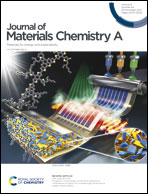Macroporous microspheres consisting of thickness-controlled bamboo-like CNTs and flower-like Co3O4 nanoparticles as highly efficient bifunctional oxygen electrocatalysts for Zn–air batteries†
Abstract
The rational design of nanostructures for efficient bifunctional oxygen electrocatalysts is necessary for their application to advanced rechargeable Zn–air batteries (ZABs). Particularly, a three-dimensional (3D) porous architecture with a high surface area enhances electrolyte transport and the charge transfer efficiency. Herein, 3D porous microspheres composed of Ni nanoparticle-embedded bamboo-like carbon nanotubes (bCNTs) with a high surface area are prepared via spray pyrolysis and post-treatment with dicyandiamide (DCDA). During the heat treatment, the thermally stable MgO matrix restricts the crystal growth of the metallic Ni nanocatalysts, which controls the thickness and length of the bCNTs. A higher MgO ratio in the MgO–Ni microspheres leads to smaller metallic Ni nanocrystals, resulting in the growth of thinner and shorter bCNTs. Through thickness and length control of the bCNTs, morphology-optimized microspheres with a high surface area exhibit a high electrochemical surface area (ECSA) and improved oxygen redox activity, especially for the oxygen reduction reaction (ORR). To compensate for the low oxygen evolution reaction (OER) activity, flower-like Co3O4 nanoparticles are decorated on the microspheres by a simple bottom-up process. The resultant composite microspheres (Co/CNT_10Mg/Ni) exhibit superior ORR and OER activities in KOH-based electrolyte compared to those of Pt/C and RuO2, respectively. Furthermore, as an air cathode for ZABs, Co/CNT_10Mg/Ni shows lower polarization, higher power density (181 mW cm−2), and a more stable cycle performance (250 h) than those of the Pt/C–RuO2 system.



 Please wait while we load your content...
Please wait while we load your content...